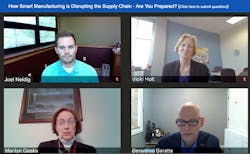De-Risking the Supply Chain: Tactics That Reduce Exposure
At a Glance:
- Notes from the SMX virtual event, “How Smart Manufacturing is Disrupting the Supply Chain—Are You Prepared?”
- Practical solutions for SMEs rethinking their global manufacturing strategies.
- Cybersecurity in digitization is a critical factor.
- A combination of nearshoring and offshoring will persist in the years to come.
Over the past decade, supply chains have undergone exponential acceleration, overcoming shocks and disruptions along the way. The pandemic, however, brought specific risk forces into sharp focus, ostensibly forcing manufacturers to re-evaluate the whole supply chain.
For one, manufacturers were surprised at the impact of China shutting down during the COVID-19 outbreak, noted Berardino Baratta VP of Projects & Engineering at MxD, a Chicago-based R&D institute that also serves as a hub for data on sector competitiveness.
It was not by accident that the premise for a keynote panel Baratta moderated at the SMX (Smart Manufacturing Experience) virtual event on Oct. 29, 2020 rested squarely on the idea that “collaboration between OEMs and suppliers is necessary to ensure an effective, efficient and informed working relationship that goes beyond the digitization of the supply chain.”
When industry players analyze their ecosystems, they are doing so to seek out the next best move. And while innovations have sprouted across supply chains, many contend that collaboration between OEMs and suppliers is emerging as the necessary condition to ensure future success.
Dealing with Risk
Supply chain risk has emerged as one of the biggest challenges of the pandemic, said Marilyn Gaska. At Lockheed Martin, Bethesda, Md., where Gaska is a fellow and the corporate logistics and sustainment chief engineer, cybersecurity is now a key area when working across the supply chain. Firms that are on a digitization quest need to ensure their digital data are secure —both locally as well as when working across the distributed supply chain, said Gaska.
In the current manufacturing environment, where the digitization process connects everything—“from design through to commercialization, commerce and quality”—cybersecurity is critical, said Vicki Holt, president and CEO of Protolabs, Maple Plain, Minn. “We’re dealing with geopolitical terror, we’re dealing with climate change, dealing with the pandemic,” she said. These forces require manufacturers to analyze their supply chains for areas of risk that would impact their ability serve customers. Manufacturers need to think about how to fortify their supply chains, advised Holt.
When the pandemic hit in March 2020, Protolabs was expedient at putting in place a COVID-19 customer response team to help innovators and manufacturers with supply chain limitations in getting their products to market quickly. “As a digital supplier, we were able to do that very rapidly in injection molding, CNC machining and in 3D printing,” explained Holt. “And today we’ve produced over 9 million parts for COVID-19-related applications to over 250 different customers. The way manufacturers were able to come together and make the supply chain work for the medical community was awesome.”
Reshore Versus Offshore
Triggers, such as the fact of China shutting down manufacturing operations, brought to the fore the prospects for reshoring, noted Baratta.
However, the panelists agreed there is no blanket solution to what’s fitting for small- and medium-sized enterprises. As Holt sees it, a combination of nearshoring and offshoring will persist in the years to come. Companies are looking at their supply chains and determining how to create redundancy in order to manage supply chains that present a lot of risk, she said.
On the upside, Holt added, the use of digital tools on e-commerce is growing in B2B commerce. “Companies can find digital suppliers they can build into their supply chain as risk mitigators,” said Holt. “Supply chain leaders are learning that e-commerce can build digital connections for their supply chain—for commerce, and all the way through quality—and can help them manage and become more of a model-based enterprise that can help them handle quality and handle revisions.”
Still, Holt cautioned, localizing the supply chain takes time because it requires reinvestment in a capital infrastructure.
Agile in Cloud-Based Systems
Product life cycles are getting shorter and companies are iterating as they go, said Holt. The supply chain will need to embrace agility so they can move with companies as they adapt, she said.
For Gaska, who is responsible for sustainment vision and technology roadmaps at Lockheed Martin, “agile” has less to do with going fast and is more about partnering across the supply chain—with users and the suppliers of data and the production statements. “Test things, work with operations and try that 80% solution and continuously improve,” she advised.
The uptake of digitization in the supply chain comes with an increase in the movement of assets through the cloud-based system, noted Baratta. “What can small manufacturers and large manufacturers do to secure that data to avoid cyber risk?” he asked.
The work-from-home transition exposed vulnerabilities that small- and medium-sized enterprises didn’t know they had, said Joel Neidig, CEO of SIMBA Chain, a cloud-based, blockchain-as-a-service (BaaS) platform based in Plymouth, Ind. “Some people were working from home [for the first time] and asking: “What’s the VPN?”
Crisis scenarios are less cut-and-dried for entities that couldn’t make quick adjustments by working remotely. On the OT side, for instance, those who remained on premise needed to make sure their programmable logic controllers or CNC controls were safe. “Trying to retool could be hundreds of thousands of dollars for a CNC machine tool that’s not worth that anymore,” said Neidig, whose company builds blockchain apps for supply chains and helps companies develop secure enclave environments where legacy equipment and software cannot be upgraded.
Firms of all sizes can develop holistic, integrated strategies that account for the different ages of equipment on the shop floor, noted Gaska. Looking holistically at both sides by leveraging the available resources—both the IT and the OT (operational technology)—will guide companies to what the cybersecurity risks are.
Practical Solutions
Theoretical discussions about Industry 4.0, digitizing and digital threads can be redundant in any reboot from the pandemic if it is not immediately applicable to small- and medium-sized manufacturers, noted Baratta.
Holt, who works extensively with SMEs, advised that firms start with needs assessment: “What are some of the biggest issues/opportunities?” she said. “Is it engaging broadly with a larger customer base, or on a direct basis? Then you might look at e-commerce solutions. Is it something on your manufacturing plant floor to drive productivity? You might want to collect data for IoT or what’s happening in your manufacturing capability. Is it in your supply chain?”
Fundamentally, said Holt, focus on one question: “What problem are you trying to solve? Then, think about how digital tools can help you get there more efficiently, as opposed to first looking at a digital tool.”
About the Author

Rehana Begg
Editor-in-Chief, Machine Design
As Machine Design’s content lead, Rehana Begg is tasked with elevating the voice of the design and multi-disciplinary engineer in the face of digital transformation and engineering innovation. Begg has more than 24 years of editorial experience and has spent the past decade in the trenches of industrial manufacturing, focusing on new technologies, manufacturing innovation and business. Her B2B career has taken her from corporate boardrooms to plant floors and underground mining stopes, covering everything from automation & IIoT, robotics, mechanical design and additive manufacturing to plant operations, maintenance, reliability and continuous improvement. Begg holds an MBA, a Master of Journalism degree, and a BA (Hons.) in Political Science. She is committed to lifelong learning and feeds her passion for innovation in publishing, transparent science and clear communication by attending relevant conferences and seminars/workshops.
Follow Rehana Begg via the following social media handles:
X: @rehanabegg
LinkedIn: @rehanabegg and @MachineDesign


